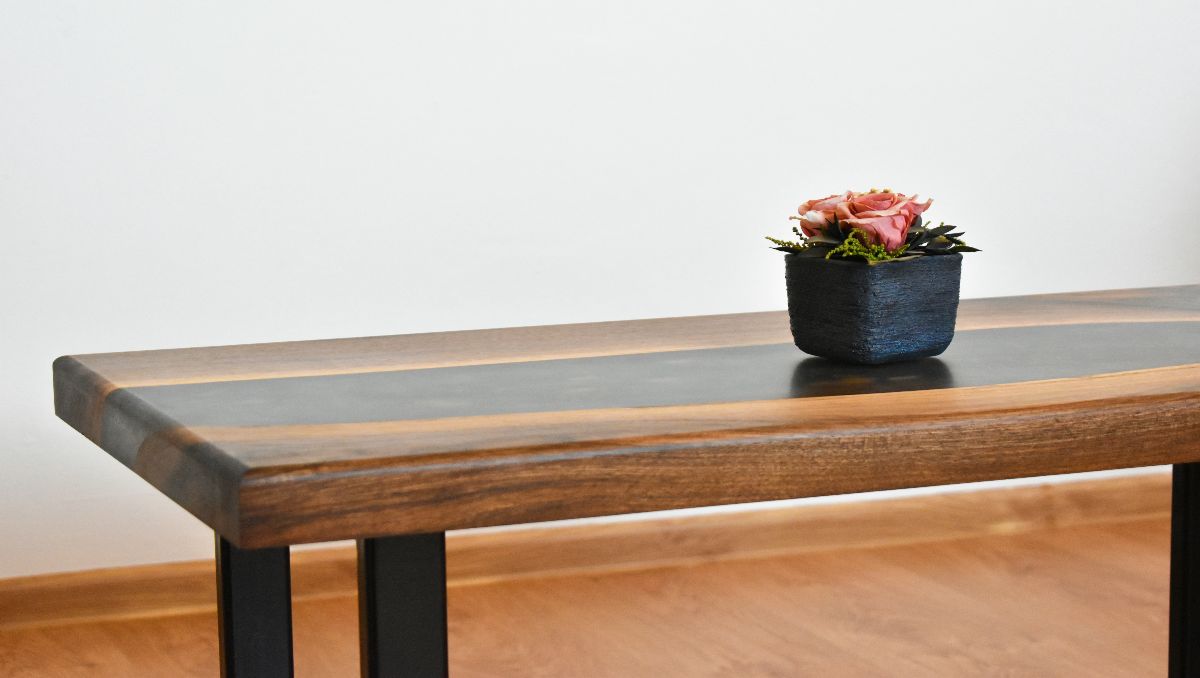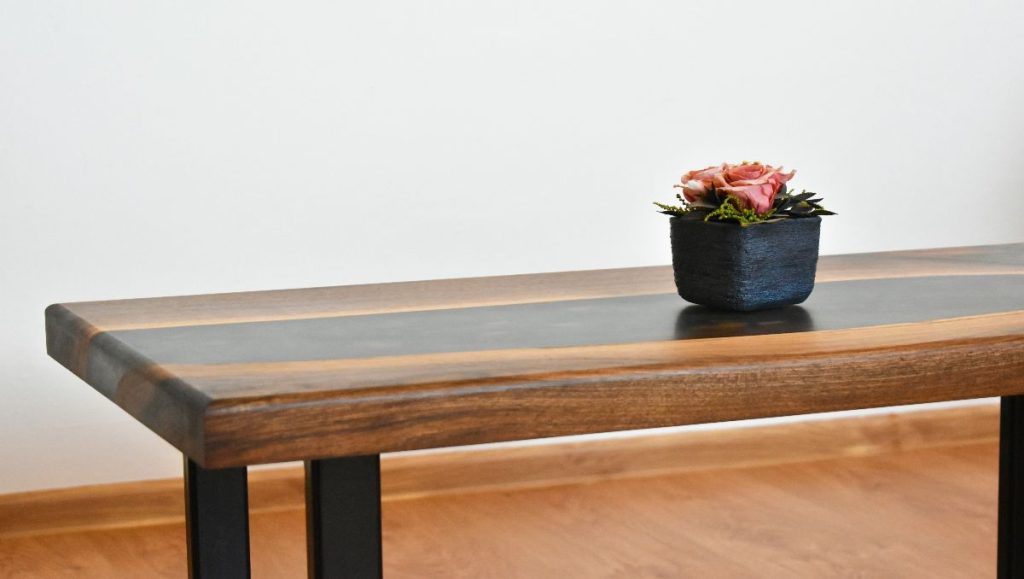
If you’re on the hunt for a solid wood tabletop, you’re not just looking for something to place in your home or office — you’re investing in a timeless piece that will last for years and likely become a family heirloom. Whether you’re making a dining table, desk, or coffee table, the right solid wood can completely transform a space. But with so many options out there, how do you choose the best wood for your needs?
Key Takeaways
- Different woods like oak, maple, and walnut have unique looks and durability. Pick one that matches your style and is easy to maintain.
- The thickness of the tabletop affects its strength and style, while the right finish protects the wood and makes it look its best.
- You can make a solid wood tabletop yourself if you’re up for it, but hiring a pro ensures a high-quality, custom piece that will last.
What’s the Big Deal About Solid Wood?
Before we dive into choosing the right tabletop, it’s important to understand why solid wood is such a sought-after material. Unlike plywood or MDF, solid wood comes from a single piece of lumber, which gives it natural beauty, strength, and longevity. Each piece is unique, showing off its own grain patterns, colors, and texture.
But solid wood isn’t just about looks. It’s tough. A well-crafted solid wood tabletop can stand the test of time, resisting wear and tear in ways that engineered woods can’t. If you’re someone who values natural materials and appreciates craftsmanship, solid wood is the way to go.
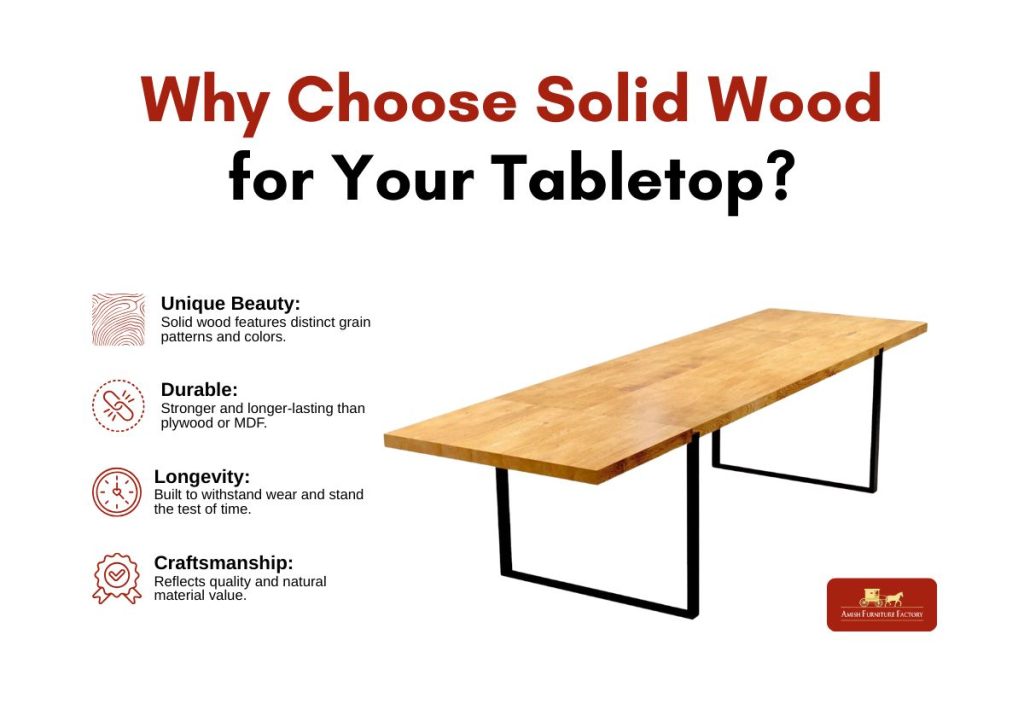
You might be interested to learn the differences between solid wood vs. rubber wood.
Key Things to Consider When Choosing a Solid Wood Tabletop
When it comes to selecting the right solid wood for your tabletop, there are a few key considerations to keep in mind. Let’s break it down.
Wood Species: Which One Should You Choose?
Different species of wood bring unique qualities to the table, each offering something special depending on your needs. Some woods are dense and sturdy, while others are lighter and easier to work with. Oak, for example, is a classic choice for a reason—it’s strong, durable, and features a beautiful, prominent grain that adds character. It’s perfect for achieving a traditional or rustic look. Maple, on the other hand, is a harder wood, making it highly durable. With its fine, smooth grain, it lends a more refined look, ideal for modern or minimalist designs.
Walnut, with its rich dark tones and stunning grain, offers a luxurious feel and makes a bold statement in any space. Cherry wood, known for its beautiful reddish hue, darkens with age, giving it a timeless, elegant appearance. When deciding which wood is best for your project, think about factors like strength, appearance, and how the wood will age over time. Also, keep in mind that some woods may require more maintenance than others.
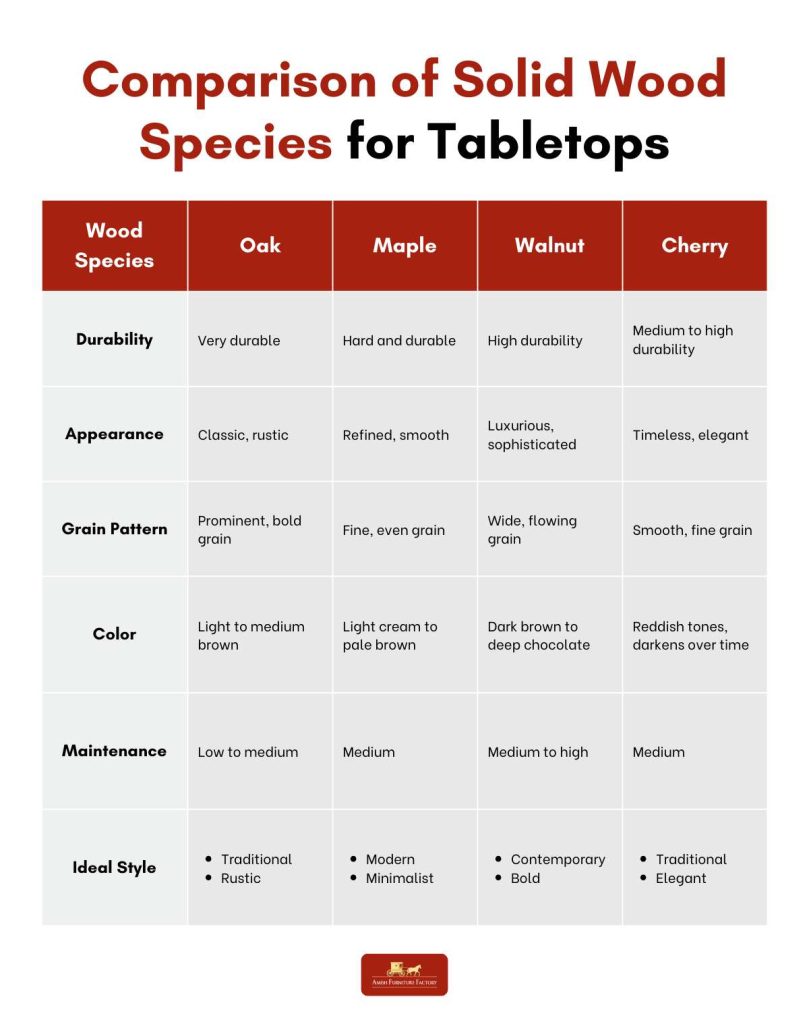
Thickness: How Thick Should Your Tabletop Be?
When you’re making a solid wood table, the thickness of the wood plays a big role in both the look and the durability. Thicker tabletops are more durable, but they also tend to be heavier and more expensive.
For a dining room table, the standard thickness is around 1.25 to 1.75 inches. If you’re looking for something with a more substantial feel, you can go up to 2 inches or more. For a desk or side table, you might opt for something thinner — around 0.75 to 1 inch — especially if you’re after a sleeker, more modern look. Remember, thicker doesn’t always mean better. It’s about finding a balance that works with your aesthetic and functional needs.
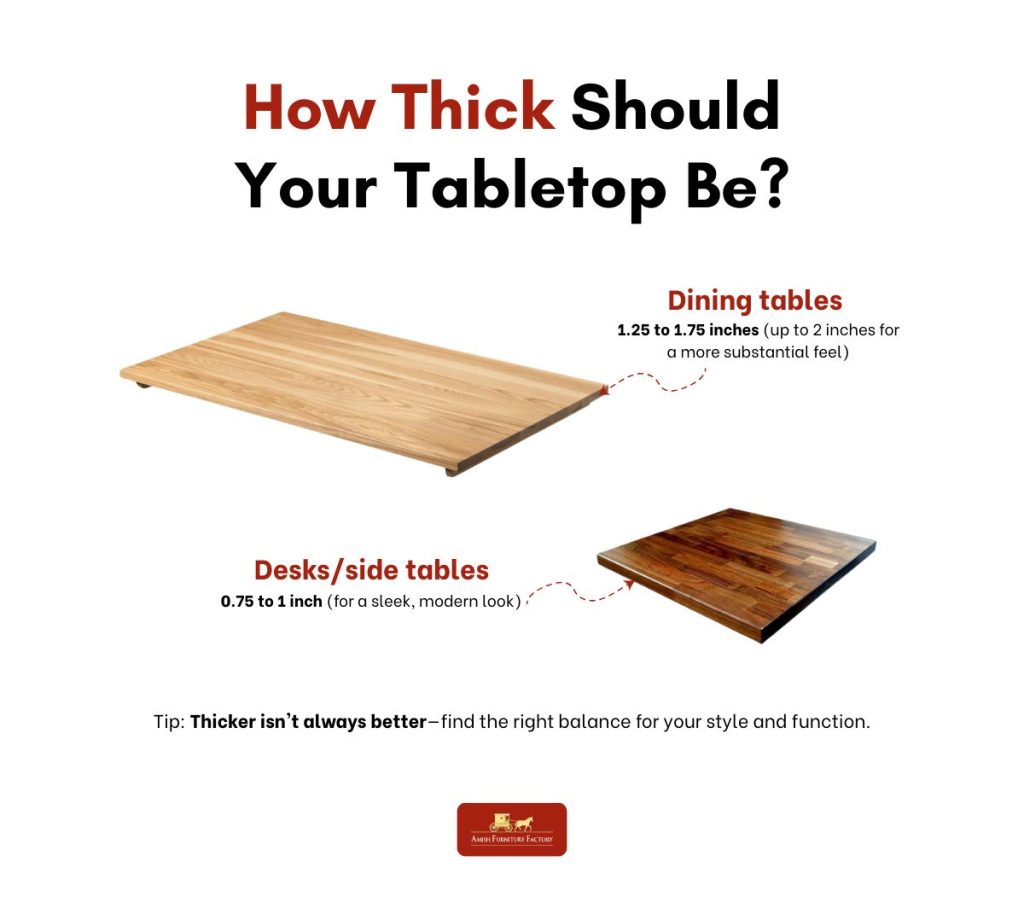
Wood Grain and Finish: The Visual Impact
Wood grain is more than just a natural feature — it’s a key part of the wood’s character. When selecting a solid wood tabletop, you’ll want to pay attention to the grain pattern. A straight grain looks clean and uniform, which is often the best choice for modern styles. A curly or wavy grain, on the other hand, adds a bit more drama and uniqueness to the piece, making it ideal for a more rustic or artistic look.
Once you’ve chosen the grain, you’ll need to think about the finish. A good finish not only protects your tabletop but also enhances the wood’s natural beauty. There are several options:
- Matte finish: Offers a natural, non-glossy look and feels less slick.
- Glossy finish: Reflects light and gives the wood a polished look.
- Oil finishes: Soak into the wood, maintaining a more natural look while offering a soft sheen.
- Lacquer or polyurethane finishes: Provide a hard, durable coating, making them great for areas prone to spills or heavy use.
Durability and Maintenance: How to Make Your Solid Wood Tabletop Last
Solid wood is durable but requires care to maintain its longevity. Protect it from moisture and heat by using coasters and placemats, and clean regularly with a soft cloth and mild cleaner. Avoid harsh chemicals, and apply furniture polish occasionally to keep the wood vibrant. When building a solid wood table, pay attention to grain direction for both beauty and strength. Sealing and finishing the wood with a durable finish, like oil-based or varnish, will protect against scratches and fading. Over time, refinishing can restore its appearance, and if needed, a professional can handle the job.
How to Make a Solid Wood Tabletop: DIY vs. Professional Craftsmanship
Now that you know the essentials of choosing a solid wood tabletop, you might be wondering: Can I make one myself? The answer is, yes, but it depends on your skill set.
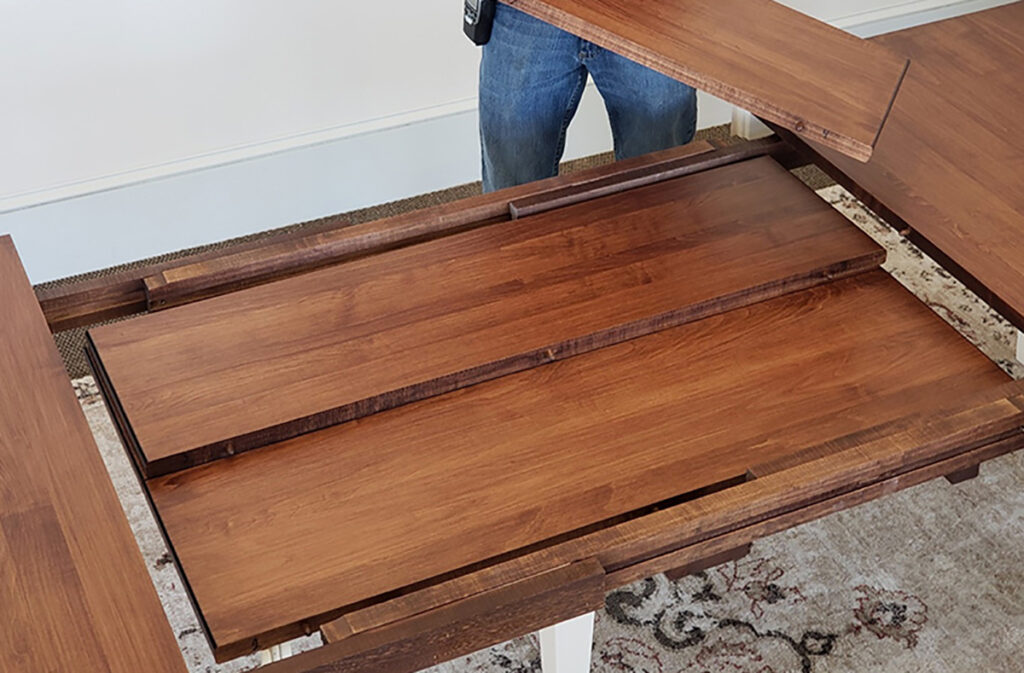
DIY Solid Wood Tabletop
Building your own solid wood tabletop is a fulfilling project that allows you to customize your furniture to your exact preferences. Here’s a step-by-step guide to help you through the process:
1. Select Your Lumber
Choose high-quality boards that suit your design and budget. Inspect each board for straightness and flatness to ensure a smooth tabletop.
2. Prepare the Boards
Use a jointer or table saw to square the edges of your boards. This step is crucial for achieving tight seams during assembly.
3. Lay Out the Boards
Arrange the boards in your desired order, considering grain patterns and color variations. Label them to maintain the arrangement during assembly.
4. Join the Boards
Align the boards and apply wood glue to the edges. Use clamps to hold them together securely while the glue dries, ensuring a flat and even surface. This also prevents wood movement.
5. Trim and Sand
Once the glue has set, trim any uneven edges and sand the surface smooth. Start with coarse-grit sandpaper and progress to finer grits for a polished finish for your flat table.
6. Apply Finish
Choose a finish that complements your wood and provides the desired level of protection. Options include stain colors, oils, or polyurethane. Apply according to the manufacturer’s instructions, allowing adequate drying time between coats.
For a visual walkthrough of the process, you might find this video tutorial helpful:
And here’s a summary of the steps which you can use as guide:
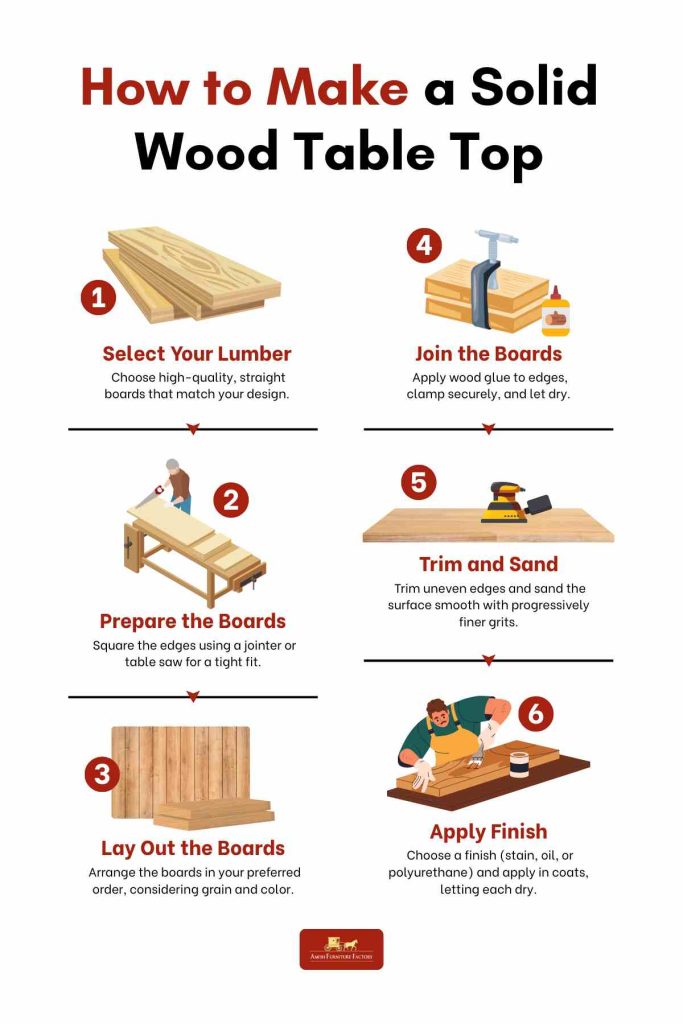
Professional Craftsmanship
If woodworking isn’t your thing or you don’t want to bother learning how to make a solid wood table top, hiring a professional might be the way to go. A skilled craftsman can help you choose the perfect wood, create a custom design, and apply the ideal finish to suit your needs. While it’s more expensive, the result is a high-quality, heirloom piece that will last for generations.
Crafted for Elegance and Durability – Explore Our Amish Dining Tables Today!
Conclusion: The Perfect Solid Wood Tabletop Awaits
Learning how to make a solid wood table top is a big decision, but it’s one that will pay off in the long run. By considering factors like wood species, thickness, grain, and finish, you’ll ensure your tabletop is not only beautiful but durable and long-lasting. Whether you decide to DIY or hire a professional, remember that the right piece of wood can add character, warmth, and style to any room.
Frequently Asked Questions
Can solid wood tabletops be repaired if damaged?
Yes, minor scratches or dents can be sanded out and refinished. For deeper damage, wood filler and refinishing may be required.
How do I prevent my solid wood tabletop from warping or cracking?
Keep your tabletop in a stable environment with consistent humidity and temperature. Avoid direct heat sources and sunlight to minimize moisture damage.
How much does a solid wood tabletop cost?
The cost can range from $200 to $1,500 or more, depending on the wood type and craftsmanship. Premium woods like walnut will be on the higher end of the price spectrum.
